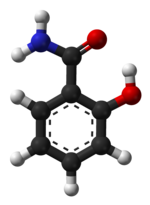Salicylamide
This is an old revision of this page, as edited by DMacks (talk | contribs) at 21:06, 19 June 2020 (Remove malformatted |molecular_weight= when infobox can autocalculate it, per Wikipedia talk:WikiProject Pharmacology#Molecular weights in drugboxes (via WP:JWB)). The present address (URL) is a permanent link to this revision, which may differ significantly from the current revision.
 | |
 | |
| Clinical data | |
|---|---|
| MedlinePlus | a681004 |
| ATC code | |
| Pharmacokinetic data | |
| Excretion | Renal |
| Identifiers | |
| |
| CAS Number |
|
| PubChem CID | |
| DrugBank |
|
| ChemSpider |
|
| UNII | |
| ChEBI | |
| ChEMBL | |
| NIAID ChemDB | |
| CompTox Dashboard (EPA) | |
| ECHA InfoCard | 100.000.554 |
| Chemical and physical data | |
| Formula | C7H7NO2 |
| Molar mass | 137.138 g·mol−1 |
| 3D model (JSmol) | |
| Density | 1.33 g/cm3 |
| Solubility in water | Soluble in hot water, ether, alcohol, and chloroform. mg/mL (20 °C) |
| |
| |
| (verify) | |
Salicylamide (o-hydroxybenzamide or amide of salicyl) is a non-prescription drug with analgesic and antipyretic properties. Its medicinal uses are similar to those of aspirin.[1] Salicylamide is used in combination with both aspirin and caffeine in the over-the-counter pain remedy PainAid. It was also an ingredient in the over-the-counter pain remedy BC Powder but was removed from the formulation in 2009. It was used in later formulations of Vincent's powders in Australia as a substitute for phenacetin.

Derivatives
Derivatives of salicylamide include, ethenzamide, Eupirone, labetalol, medroxalol, lopirin, otilonium, oxyclozanide, salicylanilide, niclosamide, and raclopride.
See also
References
- ^ "Salicylamide". Dictionary.com. Merriam-Webster's Medical Dictionary. Merriam-Webster, Inc. Retrieved December 31, 2006.
External links
| pyrazolones / pyrazolidines | |
|---|---|
| salicylates | |
| acetic acid derivatives and related substances | |
| oxicams | |
| propionic acid derivatives (profens) |
|
| n-arylanthranilic acids (fenamates) | |
| COX-2 inhibitors (coxibs) | |
| other | |
| NSAID combinations | |
Key: underline indicates initially developed first-in-class compound of specific group; #WHO-Essential Medicines; †withdrawn drugs; ‡veterinary use. | |
|
| Receptor (ligands) |
| ||||||||||||||||||||||||||
|---|---|---|---|---|---|---|---|---|---|---|---|---|---|---|---|---|---|---|---|---|---|---|---|---|---|---|---|
| Enzyme (inhibitors) |
| ||||||||||||||||||||||||||
| Others | |||||||||||||||||||||||||||
